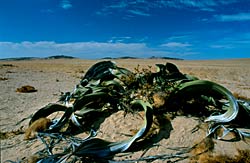The emerging Skeleton Coast/Iona Transfrontier Conservation Areas
Set in the spectacular scenery of the Namib Desert, the – transfrontier area is special in that it is relatively unspoilt by development. The perennial Kunene River separates the two countries and two contiguous conservation areas, the Skeleton Coast National Park on the Namibian side and the Iona National Park on the Angolan side. Forgotten during the war period and affected by mining and other uncontrolled uses of resources, this region is now entering a new phase to ensure the conservation and wise management of its riches.
What’s on each side
On the Angolan side, the Iona National Park extends for 15,000 square km and is the largest in the country. It is contiguous to the Namibe Reserve that lies further north. With a topography that varies from gravel plains and sand dunes on the coast to the Tchamalinde mountains in the east, through vast plains in the central area, the Park holds great potential for both conservation and tourism. War and poaching have, however, taken a toll on the area’s natural resources, and wildlife populations are today greatly reduced.
 The vegetation is predominantly sub-littoral steppe formation, with occasional pockets of Welwitschia and desert vegetation. An aerial survey conducted in 2003 showed that there is considerable presence of human populations and livestock in the mountainous areas in the east, while the drier western area is inhabited by wildlife. The vegetation is predominantly sub-littoral steppe formation, with occasional pockets of Welwitschia and desert vegetation. An aerial survey conducted in 2003 showed that there is considerable presence of human populations and livestock in the mountainous areas in the east, while the drier western area is inhabited by wildlife.
Further south in , the Skeleton Coast National Park stretches down to the Ugab River. The Park covers 16,000 square km and has a number of conservancies flanking the eastern border. Situated in the Namib Desert, animal species such as ’s desert dwelling elephant, giraffe, springbok and gemsbok can be found in the Park. Occupying the entire coastal area of ’s Kunene Region, this protected area makes the marine resources and ecologically important rivers inaccessible to local communities. The Park has been subjected to great controversy about its uses, and mining, off-road driving, recreational angling, private tourism and littering have all left marks on the environment.
Progress towards conservation and sound use of resources
Notwithstanding the issues that are threatening the biodiversity and livelihoods in both countries, progress towards sustainable management of both protected areas is being made. The event of peace in and the increasing calls for the sustainable management of coastal areas in and have made it both possible and urgent to ensure effective protection and sound use of natural resources. A Memorandum of Understanding was signed in 2003 by the Governments of Namibia and to create a transfrontier area.
Both countries have been taking important steps towards conservation objectives. The Namibia Coast Conservation and Management (NACOMA) Project, a GEF-funded project that has started implementation in 2005, will enhance the policy and institutional frameworks for the management of the country’s coastal zone including transfrontier areas. In , the ongoing process to prepare the National Biodiversity Strategy and Action Plan (NBSAP) will help move along conservation objectives in important areas such as the Iona National Park.
The Kunene River Mouth falls within the proposed Skeleton Coast/Iona Transfrontier Park. The lower reaches of the Kunene River contain flora, fauna and landscapes with high wilderness and conservation values, and the declaration of the Kunene River Mouth as a Ramsar Site has in the past been investigated but never fully pursued. While is awaiting approval of a draft Wetlands Policy, has recently adopted its National Strategy on Wetland Management and is already working towards the preparation of a National Policy. The BCLME Programme, together with parties from the three BCLME countries, is undertaking a collection of data on the region’s biodiversity.
The parallels between this transboundary region and the one further south along the Namibian/South African border are many. Both regions borders are defined by perennial rivers with river mouths with an extremely high ecological significance as rare stopping over places for migratory birds along a desert coastline. Both involve an array of protected areas that range from national parks to community-driven initiatives. Both have extremely high levels of biodiversity and unique cultures. The potential for tourism is as great in the case of the Namibian/Angolan border as the emerging Transfrontier Conservation Area (TFCA) that spans across the Namibian and Richtersveld border.
Want to know more?
Visit the library and web links sections for relevant documents about this transfrontier area.
Know more?
If you have additional information for this section please write to admin@dlist-benguela.org.
|